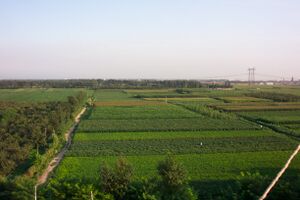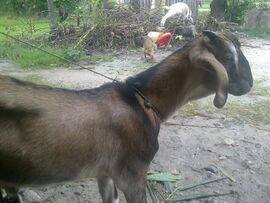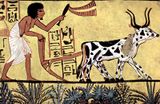مزرعة

A farm (also called an agricultural holding) is an area of land that is devoted primarily to agricultural processes with the primary objective of producing food and other crops; it is the basic facility in food production.[1] The name is used for specialized units such as arable farms, vegetable farms, fruit farms, dairy, pig and poultry farms, and land used for the production of natural fiber, biofuel and other commodities. It includes ranches, feedlots, orchards, plantations and estates, smallholdings and hobby farms, and includes the farmhouse and agricultural buildings as well as the land. In modern times the term has been extended so as to include such industrial operations as wind farms and fish farms, both of which can operate on land or sea.
There are about 570 million farms in the world, with most of which are small and family-operated. Small farms with a land area of less than 2 hectares operate about 1% of the world's agricultural land, and family farms comprise about 75% of the world's agricultural land.[2]
Modern farms in developed countries are highly mechanized. In the United States, livestock may be raised on range, land and finished in feedlots and the mechanization of crop production has brought about a great decrease in the number of agricultural workers needed. In Europe, traditional family farms are giving way to larger production units. In Australia, some farms are very large because the land is unable to support a high stocking density of livestock because of climatic conditions. In less developed countries, small farms are the norm, and the majority of rural residents are subsistence farmers, feeding their families and selling any surplus products in the local market. Acres can hold the crops.
التسمية
التاريخ
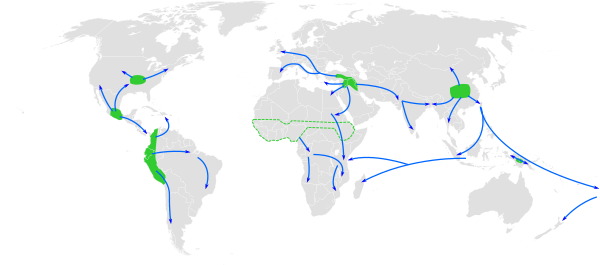
أنواع المزارع
المزارع المتخصصة
مزرعة الألبان

مزرعة الدواجن
مزرعة الخنازير
الملكية
أشكال الملكية
الأعمال التجارية الزراعية
المزارع حول العالم
الأمريكتان
أوروپا
آسيا
پاكستان
نيپال
أستراليا
أفريقيا
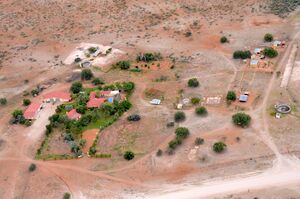
معدات المزارع
انظر أيضاً
المصادر
- ^ Gregor, 209; Adams, 454.
- ^ Lowder, Sarah K.; Skoet, Jakob; Raney, Terri (2016). "The Number, Size, and Distribution of Farms, Smallholder Farms, and Family Farms Worldwide". World Development. 87: 16–29. doi:10.1016/j.worlddev.2015.10.041.
- ^ Diamond, J.; Bellwood, P. (2003). "Farmers and Their Languages: The First Expansions" (PDF). Science. 300 (5619): 597–603. Bibcode:2003Sci...300..597D. CiteSeerX 10.1.1.1013.4523. doi:10.1126/science.1078208. PMID 12714734. S2CID 13350469.
المراجع
- Adams, Jane H. (July 1988). "The Decoupling of Farm and Household: Differential Consequences of Capitalist Development on Southern Illinois and Third World Family Farms". Comparative Studies in Society and History. 30 (3): 453–482. doi:10.1017/S0010417500015334. S2CID 154381479.
- Blackbourn, David (1998). The Long Nineteenth Century: A History of Germany, 1780–1918. New York: Oxford University Press.
- Clark, Christopher (2006). Iron Kingdom: The Rise and Downfall of Prussia, 1600–1947. Cambridge, Massachusetts: The Belknap Press of Harvard University Press.
- Gregor, Howard F. (July 1969). "Farm Structure in Regional Comparison: California and New Jersey Vegetable Farms". Economic Geography. 45 (3): 209–225. doi:10.2307/143091. JSTOR 143091.
- Grigg, David (July 1966). "The Geography of Farm Size a Preliminary Survey". Economic Geography. 42 (3): 205–235. doi:10.2307/142007. JSTOR 142007.
- Schmidt, Elizabeth (1992). Peasants, Traders, and Wives: Shona Women in the History of Zimbabwe, 1870–1939. Portsmouth, New Hampshire: Heinemann.
وصلات خارجية
- meaning of farmer, types of farmer, five richest farmers Archived 2020-07-31 at the Wayback Machine
- "Farming styles and extension in broadacre cropping". The Australian Society of Agronomy. Retrieved 18 April 2007.
- "What is Sustainable Agriculture?". University of California. December 1997. Archived from the original on 21 April 2007. Retrieved 18 April 2007.
- Diver, Steve (August 2002). "Introduction to Permaculture: Concepts and Resources". The ATTRA Project. Archived from the original on 2007-03-16. Retrieved 18 April 2007.
- Open Source Ecology
- "The National Agricultural Workers Survey". U.S. Department of Labor. Archived from the original on 16 February 2013. Retrieved 28 March 2013.






